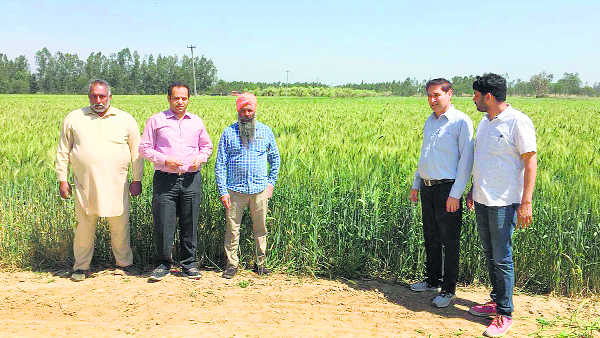
Scientists of the Krishi Vigyan Kendra and farmers at a field at Sapeda village in Ambala where wheat was sown without removing the crop residue.
Nitish Sharma
The burning of crop residue has become a major issue. Though it is a cheap option for farmers to clear their fields, it causes serious environmental pollution and health problems. Besides, it also causes loss of plant nutrients and organic carbon of the soil and thus harms the soil health.
To find a solution, the Krishi Vigyan Kendra at Tepla village in Ambala formulated a strategy and sowed wheat without removing the paddy residue on 100 hectares in Sapeda, Landa and Khudda Kalan villages of Ambala.
Guru Prem, a specialist of soil and water management, says, "To vacate fields for timely sowing of wheat, farmers burn most of the rice straw because residue interferes with tillage and seeding operations for the next crop. To deal with the issue, wheat seeds were sown into paddy residue on 100 hectares in three villages. The paddy residue provided the land with adequate moisture and also a cover to seeds."
The decision to sow wheat on 100 hectares was taken after a successful trial of sowing wheat without burning sugarcane residue on two acres last year. Some changes were made in the Happy Seeder (new-generation planters) and wheat was sown into the residue of sugarcane.
Guru Prem says, “The crop quality and yield were very good. There were no weeds in the crop and therefore there was no need to spend on weedicide. Another aspect is that about 70 per cent of fertiliser remains are found in the crop residue and the mixing of the residue back into the soil will decrease the requirement of fertiliser for the next crop”.
He says, “By adopting this method, farmers can also save water and electricity. Long-term straw application will build the soil organic matter level and nitrogen reserves, and also increase the availability of macro and micro nutrients, particularly nitrogen and sulphur, that otherwise will be lost during residue burning. Besides, farmers will be able to save about Rs 2,000 per hectare”.
Under the programme, wheat has been sown on 15 acres of farmer Ghola Singh in Sapeda village, while 12 acres of Sukhminder Singh’s fields have been covered. Scientists are expecting nearly 20 to 22 quintals per acre on a par with the wheat sown after burning the residue.
Guru Prem says, “We are expecting the yield to be the same but it may even be more. The cost of production will be much lower. The crop is maturing, it looks healthy and there are no weeds”.
Farmers can save Rs 2,000 per hectare
}By adopting this method, farmers can also save water and electricity. Long-term straw application will build the soil organic matter level and nitrogen reserves, and also increase the availability of macro and micro nutrients, particularly nitrogen and sulphur, that otherwise will be lost during residue burning. Besides, farmers will be able to save about Rs 2,000 per hectare. — Guru Prem, Specialist of soil and water management



























